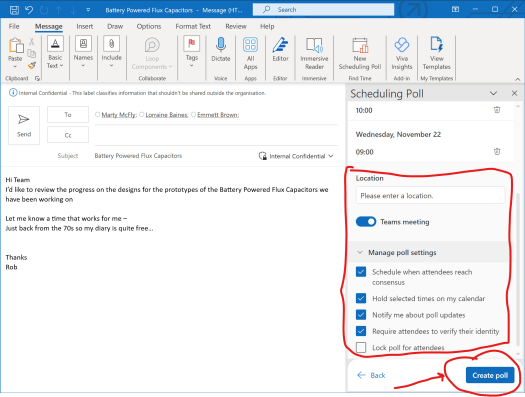I wanted to share my personal experience of using Windows 365 Cloud PC as my main device for the past 4 weeks since getting access to this as part of our partner internal use rights!

In short, I was using this both to test it out, but also because my new laptop had not arrived so I was left with the option to re-image an old one or repurpose our “home” laptop and use it as a gateway to Windows 365 – I chose the latter.
Four weeks later, using Windows 365 every day as main device, I simply can’t and don’t want to give it up. Even though I now have my brand new and awesome Surface Pro 9 device – I still haven’t get turned this on and am still choosing to use our seven year old Surface Laptop running Windows 10 (it won’t run Windows 11) with Windows 365 Cloud PC.
Why I love Windows 365
I keep asking myself the same question – why Windows 365 Cloud PC when I have a nice new Surface Pro to use. Well – Windows 365 Cloud PC gives me a seamless, secure, responsive, and flexible experience on the same device that I (and the family) share do everything else on – it’s essentially now become two devices in one and the experience is amazing – both for corporate use and for home use with out compromising anywhere!
It’s also great to have in your pocket when you bring the wrong device to work!
Here are some of the reasons why I love Windows 365 Cloud PC and how it is totally changing my perception on Cloud Computing.
- Seamless experience: With Windows 365 Cloud PC, I can access my Windows 11 Enterprise Corporate Managed Desktop instantly on my personal device (or from any other device), anytime and anywhere I need to. I don’t have to worry about syncing files, installing apps, or using web apps.
- Secure and Compliant: When traveling about, I also don’t have to worry about compromising my personal and work experiences, compromising corporate security or risk having any company data leak onto my personal device or stol n from dodgy WiFi hotspots. With Windows 365, my dideicated Cloud PC is in the Microsoft Cloud – ready for me to use at any time.
- Connecting from almost anything: I can switch from my personal laptop to my phone (I can use Samsung DEX on a TV) or even access via my Xbox via the Edge Browser. Where ever I resume from – me session is exactly where I left off.
- Responsive performance: Windows 365 Cloud PC is fast and smooth. I can run multiple apps, browse the web, and stream videos without any lag or stutter. This means the lowest spec device can perform like a powerhouse. The best part is that I don’t have to worry about the physical condition of my device, because the heavy computing work is done on the Microsoft Cloud.
- Lightening fast Internet speed always since my Cloud PC is in Azure, I get superfast access to the web and my cloud apps regardless of the speed my physical device is using.
- Flexible: Windows 365 Cloud PC is not a one-size-fits-all solution. It’s a service that can cater to different sized organisations and needs of each user.
Here’s a quote from myself about how Windows 365 Cloud PC improved my productivity and efficiency:
“Windows 365 Cloud PC is a game-changer for me. It allows me to work from anywhere, on any device, with the same performance and functionality as a physical PC. I can easily switch between tasks, collaborate with others, and access my files and apps in the cloud. I literally have my corporate desktop with me on any device at anytime, wherever I go.”
Pricing and Licensing
OK… So take a seat as on the surface the cost of Microsoft 365 can look expensive.
Firstly, Microsoft offers two subscription models, Windows 365 Business for smaller businesses and Windows 365 Enterprise for larger ones.
Prices are per user, per month subscription based and range from £26 per user per month for the base model (2CPU/4GB RAM/64GB HDD) but can be as much as £146 a month for a powerhouse configuration of 8 CPU/32GB RAM/512HDD.
Both models share the same range of features and provide thirteen Cloud PC configurations to choose from to blend the right spec with the right person and role of Cloud PC within the organisation. Here is the full range of specifications:

Unlike virtual apps and shared/pooled desktops (such as Azure Virtual Desktop), with Windows 365, each user gets a dedicated corporate Cloud PC, meaning it will run all the apps they need to use.
IT managers dream…
Managed by Intune: Like physical PCs, Windows 365 Cloud PC is managed from Intune. IT can Configure auto patch, install and schedule apps, use Autopilot for zero touch provisioning, reset and reissue devices, up size (upgrade) and down grade the specification on the fly. Intune provides details stats on performace, usage and even makes recommendations on down or up sizing of the PC based on usage and performace
Smooth Migrations: IT can choose between Windows 10 and Windows 11 (or make both available to users). This can also be helpful as a migration and training method to prepare users for Windows 11. IT can also choose to give users local admin control (or not) and can even allow users to reset their Cloud PC devices themselves.
Good bye to hardware failures: Since Windows 365 runs in the cloud, there’s no hardware to go wrong. If a users physical laptop (or TV, xbox, phone etc) fails, nothing is lost.. They can resume on a new/different device and session continues where they left of… Even the cursor stays in the sale place!
The downsides?
To be honest, from a user experience there aren’t many, unless you are working where there is no or poor internet access. Writing this, I am sat in Nero on “free wireless”, knowing my connection is secure and I’m accessing my Corporate Device through an encrypted connection, with no data leaking between the host (personal PC) and my corporate device.
The price tag can be “off putting” but the ROI is high when you take into account carbon reduction (runs in Microsoft carbon neutral data centres), cost of hardware, repairs, re imaging, recycling, replacement every 3 years, and costs due to lost or stolen devices. Do the maths…
Cloud PC is not for every one… You’ll find great use cases and bad ones.. Such as contractors, new starters, remote and over seas staff, developers, finance and other specific roles. I cover use cases in a separate blog post…
Note: Offline Access is coming for Windows 365
Free to try for 30 days
Organisations interested in trying out Windows 365 Cloud PC, can speak to their Microsoft Partner and obtain a free 30-day trial, or buy a subscription from Microsoft 365 admin centre.
I hope you enjoyed reading my blog about Windows 365 Cloud PC.
If you have any questions or feedback, please leave a comment below. Thank you for reading!


































